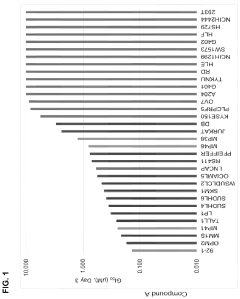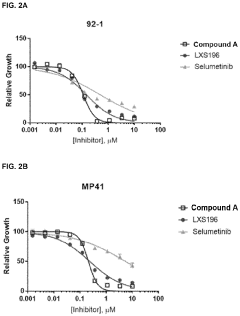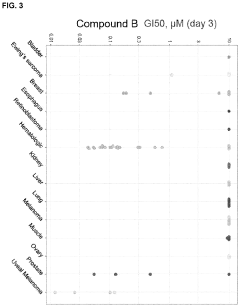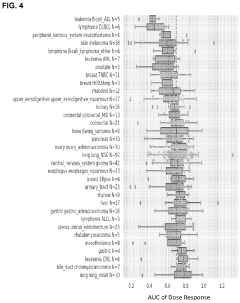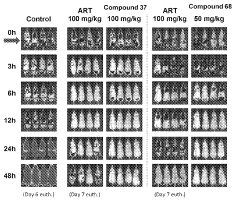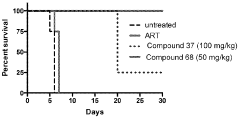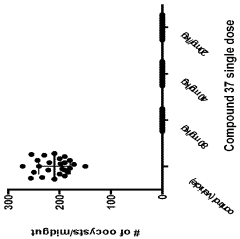Geometric Isomers in Natural Products: Identification and Activity
AUG 1, 20259 MIN READ
Generate Your Research Report Instantly with AI Agent
Patsnap Eureka helps you evaluate technical feasibility & market potential.
Natural Product Isomers: Background and Objectives
Geometric isomers in natural products have been a subject of significant interest in the field of organic chemistry and pharmacology for decades. These compounds, which possess the same molecular formula but differ in the spatial arrangement of their atoms, play a crucial role in determining the biological activity and properties of many natural substances. The study of geometric isomers in natural products has its roots in the early 20th century, with pioneering work by chemists such as Emil Fischer and Walter Norman Haworth.
The evolution of this field has been closely tied to advancements in analytical techniques and structural elucidation methods. Early research relied heavily on chemical degradation and synthesis to determine the structures of natural products. However, the advent of spectroscopic techniques, particularly nuclear magnetic resonance (NMR) spectroscopy and X-ray crystallography, revolutionized the ability to identify and characterize geometric isomers in complex natural product structures.
In recent years, the importance of geometric isomerism in natural products has gained renewed attention due to its significant impact on drug discovery and development. Many natural products and their derivatives serve as lead compounds for pharmaceutical research, and the specific geometric configuration of these molecules often determines their therapeutic efficacy. This has led to a surge in research aimed at understanding the relationship between geometric isomerism and biological activity.
The objectives of current research in this field are multifaceted. Firstly, there is a continued focus on developing more sophisticated and sensitive analytical methods for the identification and characterization of geometric isomers in complex natural product mixtures. This includes the application of advanced spectroscopic techniques, such as two-dimensional NMR and high-resolution mass spectrometry, as well as the development of novel chromatographic separation methods.
Secondly, researchers aim to elucidate the biosynthetic pathways responsible for the formation of specific geometric isomers in natural products. Understanding these pathways can provide insights into the evolutionary significance of isomerism and potentially allow for the manipulation of biosynthetic processes to produce desired isomers.
Thirdly, there is a growing emphasis on exploring the structure-activity relationships of geometric isomers in natural products. This involves systematic studies to correlate the spatial arrangement of atoms with biological activity, aiming to guide the design of more effective and selective therapeutic agents.
Lastly, the field is moving towards integrating computational methods with experimental approaches. Advanced molecular modeling and machine learning techniques are being employed to predict the occurrence of geometric isomers in natural products and to simulate their interactions with biological targets.
The evolution of this field has been closely tied to advancements in analytical techniques and structural elucidation methods. Early research relied heavily on chemical degradation and synthesis to determine the structures of natural products. However, the advent of spectroscopic techniques, particularly nuclear magnetic resonance (NMR) spectroscopy and X-ray crystallography, revolutionized the ability to identify and characterize geometric isomers in complex natural product structures.
In recent years, the importance of geometric isomerism in natural products has gained renewed attention due to its significant impact on drug discovery and development. Many natural products and their derivatives serve as lead compounds for pharmaceutical research, and the specific geometric configuration of these molecules often determines their therapeutic efficacy. This has led to a surge in research aimed at understanding the relationship between geometric isomerism and biological activity.
The objectives of current research in this field are multifaceted. Firstly, there is a continued focus on developing more sophisticated and sensitive analytical methods for the identification and characterization of geometric isomers in complex natural product mixtures. This includes the application of advanced spectroscopic techniques, such as two-dimensional NMR and high-resolution mass spectrometry, as well as the development of novel chromatographic separation methods.
Secondly, researchers aim to elucidate the biosynthetic pathways responsible for the formation of specific geometric isomers in natural products. Understanding these pathways can provide insights into the evolutionary significance of isomerism and potentially allow for the manipulation of biosynthetic processes to produce desired isomers.
Thirdly, there is a growing emphasis on exploring the structure-activity relationships of geometric isomers in natural products. This involves systematic studies to correlate the spatial arrangement of atoms with biological activity, aiming to guide the design of more effective and selective therapeutic agents.
Lastly, the field is moving towards integrating computational methods with experimental approaches. Advanced molecular modeling and machine learning techniques are being employed to predict the occurrence of geometric isomers in natural products and to simulate their interactions with biological targets.
Market Demand for Isomer-Specific Natural Products
The market demand for isomer-specific natural products has been steadily growing in recent years, driven by advancements in analytical techniques and a deeper understanding of the biological activities of geometric isomers. This trend is particularly evident in the pharmaceutical, nutraceutical, and cosmetic industries, where the specific stereochemistry of compounds can significantly impact their efficacy and safety profiles.
In the pharmaceutical sector, there is an increasing focus on developing drugs with precise stereochemical configurations to optimize therapeutic effects and minimize side effects. This has led to a surge in demand for natural products with well-defined geometric isomers, as these compounds often serve as lead structures for drug discovery and development. The market for such products is expected to expand further as regulatory agencies place greater emphasis on the stereochemical purity of drug substances.
The nutraceutical industry has also witnessed a rising interest in isomer-specific natural products. Consumers are becoming more aware of the potential health benefits associated with specific isomeric forms of compounds such as omega-3 fatty acids, carotenoids, and flavonoids. This awareness has translated into a growing market for supplements and functional foods that contain precisely defined isomeric compositions, promising enhanced bioavailability and targeted health benefits.
Cosmetic companies are increasingly incorporating isomer-specific natural products into their formulations, capitalizing on the unique properties of certain geometric isomers. For instance, specific isomers of retinoids and vitamin E derivatives are sought after for their superior skin-penetrating abilities and antioxidant properties. This trend is expected to continue as consumers demand more effective and scientifically backed beauty products.
The agricultural sector is another area where the demand for isomer-specific natural products is on the rise. Pest control strategies are evolving to utilize specific isomers of pheromones and other semiochemicals, which offer improved efficacy and environmental safety compared to traditional pesticides. This shift is driving the market for natural product-based agrochemicals with defined stereochemistry.
As research continues to uncover the distinct biological activities of different geometric isomers, the market is likely to see an increased demand for analytical services and technologies capable of accurately identifying and quantifying these isomers in complex natural product mixtures. This, in turn, is expected to fuel innovation in separation and characterization techniques, further expanding the market for isomer-specific natural products across various industries.
In the pharmaceutical sector, there is an increasing focus on developing drugs with precise stereochemical configurations to optimize therapeutic effects and minimize side effects. This has led to a surge in demand for natural products with well-defined geometric isomers, as these compounds often serve as lead structures for drug discovery and development. The market for such products is expected to expand further as regulatory agencies place greater emphasis on the stereochemical purity of drug substances.
The nutraceutical industry has also witnessed a rising interest in isomer-specific natural products. Consumers are becoming more aware of the potential health benefits associated with specific isomeric forms of compounds such as omega-3 fatty acids, carotenoids, and flavonoids. This awareness has translated into a growing market for supplements and functional foods that contain precisely defined isomeric compositions, promising enhanced bioavailability and targeted health benefits.
Cosmetic companies are increasingly incorporating isomer-specific natural products into their formulations, capitalizing on the unique properties of certain geometric isomers. For instance, specific isomers of retinoids and vitamin E derivatives are sought after for their superior skin-penetrating abilities and antioxidant properties. This trend is expected to continue as consumers demand more effective and scientifically backed beauty products.
The agricultural sector is another area where the demand for isomer-specific natural products is on the rise. Pest control strategies are evolving to utilize specific isomers of pheromones and other semiochemicals, which offer improved efficacy and environmental safety compared to traditional pesticides. This shift is driving the market for natural product-based agrochemicals with defined stereochemistry.
As research continues to uncover the distinct biological activities of different geometric isomers, the market is likely to see an increased demand for analytical services and technologies capable of accurately identifying and quantifying these isomers in complex natural product mixtures. This, in turn, is expected to fuel innovation in separation and characterization techniques, further expanding the market for isomer-specific natural products across various industries.
Current Challenges in Geometric Isomer Identification
The identification of geometric isomers in natural products presents several significant challenges that researchers and analytical chemists must overcome. One of the primary difficulties lies in the structural similarity between geometric isomers, which often results in nearly identical physical and chemical properties. This similarity makes traditional separation techniques, such as chromatography, less effective in isolating and distinguishing between these isomers.
Mass spectrometry, a powerful analytical tool, also faces limitations when dealing with geometric isomers. The fragmentation patterns of these compounds are often indistinguishable, making it challenging to differentiate between isomers based solely on mass spectral data. This necessitates the development of more sophisticated analytical approaches that can provide unambiguous structural information.
Nuclear Magnetic Resonance (NMR) spectroscopy, while useful for structural elucidation, can sometimes yield ambiguous results for geometric isomers, especially in complex natural product mixtures. The interpretation of NMR data for these compounds often requires advanced expertise and may not always lead to definitive conclusions.
Another significant challenge is the potential for isomerization during the isolation and purification processes. Many geometric isomers are sensitive to environmental factors such as light, heat, or pH changes. This instability can lead to the interconversion of isomers during sample preparation or analysis, further complicating the identification process.
The biological activity of geometric isomers can vary significantly, despite their structural similarities. This presents a challenge in structure-activity relationship studies and drug discovery efforts, as it becomes crucial to accurately identify and characterize each isomer to understand its specific biological effects.
In natural product extracts, geometric isomers often occur in low concentrations, making their detection and isolation even more challenging. This requires the development of highly sensitive analytical methods capable of detecting and characterizing trace amounts of these compounds in complex matrices.
The lack of standardized protocols for geometric isomer identification in natural products further complicates the field. Different research groups may employ varying methodologies, leading to inconsistencies in results and difficulties in comparing findings across studies. This highlights the need for the establishment of robust, universally accepted analytical procedures for geometric isomer identification.
Computational methods, while increasingly powerful, still face limitations in accurately predicting the structures and properties of geometric isomers in complex natural product systems. The development of more sophisticated algorithms and models that can reliably distinguish between geometric isomers remains an ongoing challenge in the field.
Mass spectrometry, a powerful analytical tool, also faces limitations when dealing with geometric isomers. The fragmentation patterns of these compounds are often indistinguishable, making it challenging to differentiate between isomers based solely on mass spectral data. This necessitates the development of more sophisticated analytical approaches that can provide unambiguous structural information.
Nuclear Magnetic Resonance (NMR) spectroscopy, while useful for structural elucidation, can sometimes yield ambiguous results for geometric isomers, especially in complex natural product mixtures. The interpretation of NMR data for these compounds often requires advanced expertise and may not always lead to definitive conclusions.
Another significant challenge is the potential for isomerization during the isolation and purification processes. Many geometric isomers are sensitive to environmental factors such as light, heat, or pH changes. This instability can lead to the interconversion of isomers during sample preparation or analysis, further complicating the identification process.
The biological activity of geometric isomers can vary significantly, despite their structural similarities. This presents a challenge in structure-activity relationship studies and drug discovery efforts, as it becomes crucial to accurately identify and characterize each isomer to understand its specific biological effects.
In natural product extracts, geometric isomers often occur in low concentrations, making their detection and isolation even more challenging. This requires the development of highly sensitive analytical methods capable of detecting and characterizing trace amounts of these compounds in complex matrices.
The lack of standardized protocols for geometric isomer identification in natural products further complicates the field. Different research groups may employ varying methodologies, leading to inconsistencies in results and difficulties in comparing findings across studies. This highlights the need for the establishment of robust, universally accepted analytical procedures for geometric isomer identification.
Computational methods, while increasingly powerful, still face limitations in accurately predicting the structures and properties of geometric isomers in complex natural product systems. The development of more sophisticated algorithms and models that can reliably distinguish between geometric isomers remains an ongoing challenge in the field.
Existing Methods for Geometric Isomer Identification
01 Identification of geometric isomers in natural products
Various analytical techniques are employed to identify geometric isomers in natural products. These methods include spectroscopic techniques such as NMR, X-ray crystallography, and chromatographic methods. Advanced computational tools and algorithms are also used to predict and confirm the structures of geometric isomers found in nature.- Identification of geometric isomers in natural products: Various analytical techniques are employed to identify geometric isomers in natural products. These methods include spectroscopic techniques such as NMR, X-ray crystallography, and chromatographic methods. Advanced computational tools and algorithms are also used to predict and confirm the structures of geometric isomers found in natural sources.
- Biological activity of geometric isomers in natural products: Geometric isomers found in natural products often exhibit different biological activities. Research focuses on understanding how the spatial arrangement of atoms in these isomers affects their interactions with biological targets. This knowledge is crucial for developing new drugs, pesticides, and other bioactive compounds based on natural product scaffolds.
- Synthesis and modification of geometric isomers: Synthetic methods are developed to produce specific geometric isomers of natural products or to modify existing ones. These techniques aim to enhance desired properties or create novel compounds with improved biological activity. Stereoselective synthesis and isomerization reactions play key roles in this area of research.
- Separation and purification of geometric isomers: Efficient separation and purification techniques are crucial for isolating specific geometric isomers from natural product mixtures. Advanced chromatographic methods, including chiral separation techniques, are employed to achieve high-purity isomers for further study or application.
- Applications of geometric isomers from natural products: Geometric isomers derived from natural products find applications in various fields, including pharmaceuticals, agrochemicals, and food additives. Research focuses on exploiting the unique properties of these isomers to develop new products with enhanced efficacy, reduced side effects, or improved stability compared to their counterparts.
02 Biological activity of geometric isomers in natural products
Geometric isomers in natural products often exhibit different biological activities. Research focuses on understanding how the spatial arrangement of atoms in these isomers affects their interactions with biological targets. This knowledge is crucial for developing new drugs and improving existing ones based on natural product scaffolds.Expand Specific Solutions03 Synthesis and modification of geometric isomers
Researchers develop methods to synthesize and modify geometric isomers found in natural products. These techniques aim to create libraries of compounds for structure-activity relationship studies and to optimize the properties of natural products for various applications, including pharmaceuticals and agrochemicals.Expand Specific Solutions04 Separation and purification of geometric isomers
Efficient separation and purification techniques are crucial for isolating geometric isomers from natural sources or synthetic mixtures. Advanced chromatographic methods, including chiral separation techniques, are developed to achieve high-purity isolation of individual geometric isomers for further study and application.Expand Specific Solutions05 Applications of geometric isomers from natural products
Geometric isomers derived from natural products find applications in various fields, including pharmaceuticals, cosmetics, and food additives. Research focuses on exploiting the unique properties of these isomers to develop novel products with enhanced efficacy, stability, or sensory characteristics.Expand Specific Solutions
Key Players in Natural Product Isomer Research
The field of geometric isomers in natural products is in a mature stage of development, with a well-established market and significant research interest. The global market for natural products, including those with geometric isomers, is substantial and growing, driven by increasing demand for plant-based pharmaceuticals and nutraceuticals. Technologically, the identification and activity analysis of geometric isomers have advanced considerably, with companies like Sunshine Lake Pharma, Ambrx, and Astex Therapeutics leading in innovative approaches. These firms, along with research institutions such as Dana-Farber Cancer Institute and The Broad Institute, are pushing the boundaries of isomer characterization and its applications in drug discovery. The competitive landscape is diverse, with pharmaceutical giants like Pfizer and Bayer competing alongside specialized biotech firms, indicating a mature but still evolving field with potential for breakthrough discoveries.
Sunshine Lake Pharma Co., Ltd.
Technical Solution: Sunshine Lake Pharma has focused on developing novel synthetic methodologies for controlling geometric isomerism in natural product analogues. Their approach utilizes stereospecific catalysts and photochemical reactions to selectively produce desired geometric isomers[7]. This method allows for the efficient synthesis of libraries of geometric isomers based on natural product scaffolds. The company has also implemented a high-throughput bioassay platform to rapidly evaluate the biological activities of these synthetic isomers, enabling the identification of structure-activity relationships specific to geometric configuration[8]. Additionally, Sunshine Lake Pharma has developed a computational model that predicts the impact of geometric isomerism on drug-target interactions, facilitating the design of more potent and selective compounds.
Strengths: Controlled synthesis of specific isomers, rapid biological activity screening, structure-based drug design capabilities. Weaknesses: May be limited to certain classes of natural product scaffolds amenable to synthetic modification.
Bayer Intellectual Property GmbH
Technical Solution: Bayer has developed advanced spectroscopic techniques for the identification of geometric isomers in natural products. Their approach combines high-resolution NMR spectroscopy with computational modeling to elucidate the three-dimensional structures of complex natural compounds[1]. This method allows for the precise determination of cis/trans configurations in cyclic and acyclic systems. Additionally, Bayer has implemented a novel chromatographic separation technique that utilizes chiral stationary phases to isolate and purify individual geometric isomers from complex mixtures[3]. This enables the company to study the biological activities of specific isomers in isolation, leading to more targeted drug development processes.
Strengths: Highly accurate structure determination, efficient separation of isomers. Weaknesses: Potentially time-consuming and resource-intensive processes for complex molecules.
Innovative Approaches in Isomer Activity Determination
Compounds and uses thereof
PatentPendingUS20230145003A1
Innovation
- Development of specific compounds that modulate the BAF complex by inhibiting BRG1 and/or BRM activity, which can be used alone or in combination with other pharmaceutically active agents to treat disorders like cancer.
Compounds and methods for the treatment of malaria
PatentInactiveIN202118043692A
Innovation
- Development of specific compounds, such as those represented by Formula I and listed in Table 1, which offer new structural features and functional groups to target malaria parasites effectively, including those resistant to existing drugs.
Regulatory Considerations for Isomer-Specific Products
The regulatory landscape for isomer-specific products in the field of natural products is complex and multifaceted. Regulatory bodies, such as the FDA in the United States and the EMA in Europe, have established guidelines for the development and approval of isomer-specific products. These guidelines emphasize the importance of characterizing and controlling the isomeric composition of natural products throughout the development and manufacturing processes.
One of the primary regulatory considerations is the need for accurate and precise analytical methods to identify and quantify geometric isomers in natural products. Regulatory agencies require manufacturers to demonstrate the ability to consistently produce and control the isomeric composition of their products. This often involves the development and validation of sophisticated analytical techniques, such as chiral chromatography or spectroscopic methods, to distinguish between geometric isomers.
Safety and efficacy assessments for isomer-specific products present unique challenges from a regulatory perspective. Regulatory bodies typically require comprehensive data on the pharmacological and toxicological profiles of individual isomers, as well as their mixtures. This may involve conducting separate clinical trials for different isomeric forms to establish their respective safety and efficacy profiles.
The issue of isomeric purity is another critical regulatory consideration. Manufacturers must establish and justify acceptable limits for isomeric impurities in their products. This often requires the development of robust purification processes and quality control measures to ensure consistent isomeric composition across batches.
Labeling and marketing of isomer-specific products are subject to strict regulatory oversight. Product labels must accurately reflect the isomeric composition and any potential differences in activity between isomers. Claims regarding the superiority of specific isomeric forms must be substantiated with robust scientific evidence.
Regulatory agencies also focus on the potential for isomeric interconversion during storage and use. Manufacturers are required to demonstrate the stability of their isomer-specific products under various conditions and provide appropriate storage and handling instructions to maintain isomeric integrity.
In the context of natural products, regulatory bodies often require additional considerations regarding the sourcing and standardization of raw materials. This may involve implementing rigorous quality control measures to ensure consistent isomeric profiles in naturally derived ingredients.
As the field of isomer-specific natural products continues to evolve, regulatory frameworks are likely to adapt to address emerging challenges and opportunities. This may include the development of new guidelines for novel analytical techniques or the refinement of existing regulations to better accommodate the unique characteristics of geometric isomers in natural products.
One of the primary regulatory considerations is the need for accurate and precise analytical methods to identify and quantify geometric isomers in natural products. Regulatory agencies require manufacturers to demonstrate the ability to consistently produce and control the isomeric composition of their products. This often involves the development and validation of sophisticated analytical techniques, such as chiral chromatography or spectroscopic methods, to distinguish between geometric isomers.
Safety and efficacy assessments for isomer-specific products present unique challenges from a regulatory perspective. Regulatory bodies typically require comprehensive data on the pharmacological and toxicological profiles of individual isomers, as well as their mixtures. This may involve conducting separate clinical trials for different isomeric forms to establish their respective safety and efficacy profiles.
The issue of isomeric purity is another critical regulatory consideration. Manufacturers must establish and justify acceptable limits for isomeric impurities in their products. This often requires the development of robust purification processes and quality control measures to ensure consistent isomeric composition across batches.
Labeling and marketing of isomer-specific products are subject to strict regulatory oversight. Product labels must accurately reflect the isomeric composition and any potential differences in activity between isomers. Claims regarding the superiority of specific isomeric forms must be substantiated with robust scientific evidence.
Regulatory agencies also focus on the potential for isomeric interconversion during storage and use. Manufacturers are required to demonstrate the stability of their isomer-specific products under various conditions and provide appropriate storage and handling instructions to maintain isomeric integrity.
In the context of natural products, regulatory bodies often require additional considerations regarding the sourcing and standardization of raw materials. This may involve implementing rigorous quality control measures to ensure consistent isomeric profiles in naturally derived ingredients.
As the field of isomer-specific natural products continues to evolve, regulatory frameworks are likely to adapt to address emerging challenges and opportunities. This may include the development of new guidelines for novel analytical techniques or the refinement of existing regulations to better accommodate the unique characteristics of geometric isomers in natural products.
Environmental Impact of Isomer-Specific Natural Product Extraction
The extraction of specific geometric isomers from natural products has significant environmental implications that warrant careful consideration. The process of isolating and purifying these compounds often involves complex chemical procedures and the use of various solvents, which can have substantial ecological impacts.
One of the primary environmental concerns is the generation of chemical waste during the extraction and purification processes. Many of the solvents used in these procedures are organic compounds that can be harmful to ecosystems if released into the environment. These chemicals may persist in soil and water, potentially affecting plant and animal life. Additionally, the disposal of these waste products requires specialized handling and treatment facilities, which themselves have environmental footprints.
The energy consumption associated with isomer-specific extraction is another critical factor. Many separation techniques, such as high-performance liquid chromatography (HPLC) or gas chromatography, require significant amounts of electricity to operate. This increased energy demand contributes to greenhouse gas emissions if the power source is not renewable.
Furthermore, the sourcing of natural products for isomer extraction can lead to habitat disruption and biodiversity loss if not managed sustainably. Over-harvesting of plant species for their valuable isomers can deplete natural populations and disrupt ecosystems. This is particularly concerning for rare or endangered species that may contain unique isomeric compounds of interest.
Water usage is also a significant environmental consideration in isomer extraction processes. Many purification techniques require large volumes of water, which can strain local water resources, especially in water-scarce regions. The contamination of water sources with chemical residues from these processes is an additional risk that must be carefully managed.
However, it is important to note that the environmental impact of isomer-specific extraction can be mitigated through various strategies. The development of green chemistry techniques, such as using supercritical CO2 as a solvent, can reduce the reliance on harmful organic solvents. Additionally, the implementation of closed-loop systems and solvent recycling can minimize waste generation and resource consumption.
Advances in biotechnology, such as the use of engineered microorganisms for the production of specific isomers, offer promising alternatives to traditional extraction methods. These approaches can potentially reduce the need for extensive chemical processing and minimize environmental impacts associated with natural resource extraction.
One of the primary environmental concerns is the generation of chemical waste during the extraction and purification processes. Many of the solvents used in these procedures are organic compounds that can be harmful to ecosystems if released into the environment. These chemicals may persist in soil and water, potentially affecting plant and animal life. Additionally, the disposal of these waste products requires specialized handling and treatment facilities, which themselves have environmental footprints.
The energy consumption associated with isomer-specific extraction is another critical factor. Many separation techniques, such as high-performance liquid chromatography (HPLC) or gas chromatography, require significant amounts of electricity to operate. This increased energy demand contributes to greenhouse gas emissions if the power source is not renewable.
Furthermore, the sourcing of natural products for isomer extraction can lead to habitat disruption and biodiversity loss if not managed sustainably. Over-harvesting of plant species for their valuable isomers can deplete natural populations and disrupt ecosystems. This is particularly concerning for rare or endangered species that may contain unique isomeric compounds of interest.
Water usage is also a significant environmental consideration in isomer extraction processes. Many purification techniques require large volumes of water, which can strain local water resources, especially in water-scarce regions. The contamination of water sources with chemical residues from these processes is an additional risk that must be carefully managed.
However, it is important to note that the environmental impact of isomer-specific extraction can be mitigated through various strategies. The development of green chemistry techniques, such as using supercritical CO2 as a solvent, can reduce the reliance on harmful organic solvents. Additionally, the implementation of closed-loop systems and solvent recycling can minimize waste generation and resource consumption.
Advances in biotechnology, such as the use of engineered microorganisms for the production of specific isomers, offer promising alternatives to traditional extraction methods. These approaches can potentially reduce the need for extensive chemical processing and minimize environmental impacts associated with natural resource extraction.
Unlock deeper insights with Patsnap Eureka Quick Research — get a full tech report to explore trends and direct your research. Try now!
Generate Your Research Report Instantly with AI Agent
Supercharge your innovation with Patsnap Eureka AI Agent Platform!
